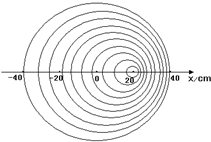问题
问答题
如图所示,小球P一边贴着水面每秒振动5次,一边沿x轴正方向匀速移动,x=0点
是它的初始位置,图示为恰经10个周期时观察到的水面波,此时小球运动到x=20cm处.问:
(1)在x=-20cm处的浮子的振动频率比波源频率大还是小?
(2)小球P匀速移动的速度及此水面波的传播速度分别多大?

答案
(1)由图可知,质点在向右移动,故在x=-20cm处的浮子的振动频率比波源频率小
(2)小球P振动的周期T=
s=0.2s1 5
小球P振动10个周期所用时间t=10T=2s
小球P的速度v1=
=s1 t
m/s=0.1m/s0.2 2
水面波的传播速度v2=
=s2 t
m/s=0.2m/s;0.4 2
答:x=-20cm处的浮子的振动频率比波源频率小;(2)小球P的速度为0.1m/s,水面波的传播速度为0.2m/s.
